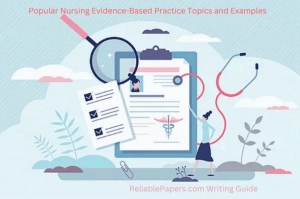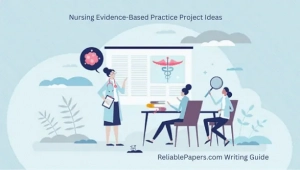How to Write a Community Health Needs Assessment Report

Embarking on the journey of creating a community health needs assessment report is like diving into the heart of a community’s health requirements.
For nursing students, this process is all about unearthing vital information about a community’s health status, behaviors, and all those factors that can sway their health outcomes. Imagine employing various methods such as surveys, interviews, and heart-to-heart discussions to gather data about the community’s health needs, what they hold as priorities, and what challenges they grapple with.
By conducting such an assessment, nursing students get to step right into the shoes of the community they’re serving. It’s like unlocking a treasure chest of insight that allows them to craft strategies that hit the mark when it comes to addressing these specific needs. This process doesn’t only enrich the knowledge of nursing students about their patients; it’s also a boon for healthcare organizations and decision-makers. They get a blueprint to shape programs and policies that are custom-tailored to fit the very healthcare puzzle of that community.
You can think of a community health needs assessment as a crucial part of nursing education. It arms nursing students with the knowledge and skills they need to deliver top-notch healthcare to their patient community. It’s like forging a bridge between classroom learning and real-world healthcare delivery.
Our nursing writing experts have also created an extensive guide on how to write nursing term papers, designed to support nursing students in their writing endeavors.
What Is the Purpose of a Community Health Needs Assessment Report Paper
When we talk about a community health needs assessment report, we’re really talking about understanding a community on a deeper level – getting to the heart of what that community truly needs and the challenges it faces. The ultimate aim is to come up with smart and effective plans to tackle these very needs.
This report, think of it as a detailed account, doesn’t just stop at showing what was discovered during the assessment. It also lays out the roadmap for how to deal with the healthcare needs that were uncovered.
This report is more than just pages and words; it’s a lifeline. It’s like a valuable tool for healthcare groups, decision-makers, and dedicated nursing professionals. They can take the insights from this report and shape healthcare initiatives and policies that aren’t one-size-fits-all. Instead, they’re tailor-made to fit exactly what the community needs in terms of healthcare.
Importance of Community Health Needs Assessment for Nursing Students
Community health needs assessment is an important process that helps nursing students identify the health needs of a specific community and develop evidence-based recommendations for addressing these needs. The process of conducting a community needs assessment allows nursing students to:
The whole idea of a community health needs assessment is like uncovering a treasure map that helps nursing students pinpoint the health needs of a particular community and then chart out well-informed paths to tackle those needs. But this process is more than just a task. It’s a chance for nursing students to:
- Get to the Heart of Community Health: Imagine nursing students stepping into the shoes of the community they’re serving. By diving into a community health needs assessment, they’re not just reading the surface; they’re delving deep into the community’s health landscape. This lets them truly grasp the health challenges the community faces and then craft laser-focused plans to address these issues head-on.
- Forge Genuine Bonds with Community Members: Think of the assessment as a bridge between nursing students and the community. It’s a chance for them to meet, connect, and truly understand the people they’re here to serve. These interactions build trust and ensure that the interventions and programs they design are genuinely rooted in the community’s needs.
- Develop Skills in Collecting and Analyzing Data: Imagine nursing students becoming data wizards. Through this assessment, they learn how to gather and interpret information about the community’s health. They become experts at not only understanding the health needs of the community but also spotting the social and environmental factors that play into the health equation.
- Base Actions on Solid Evidence: Consider this assessment as the compass needle pointing towards evidence-based action. By using the data they’ve collected, nursing students can fashion recommendations that are backed by solid evidence. This means interventions and programs are designed to be effective and tailored to the community’s specific needs.
- Shape Healthier Communities: Think of nursing students as architects of wellness. This assessment isn’t just about numbers and charts. It’s about crafting healthier communities. By shining a light on the community’s health needs and steering targeted actions, nursing students become advocates for better health. They help community members live healthier lives by nudging behaviors and creating environments that promote well-being.
Ultimately, community health needs assessment isn’t just a box to check – it’s a key that unlocks the potential for nursing students to make a real difference, one community at a time.
Types of Community Health Needs Assessment for Nursing Students
There are several types of community health needs assessments that nursing students can use to identify the health needs of a community. Some of the most common types of community needs assessments include:
- Comprehensive Health Needs Assessment: Think of this like putting together a puzzle. A comprehensive health needs assessment is like carefully fitting all the pieces together to understand a community’s health needs. It’s a methodical process that involves gathering data from various sources – surveys, heart-to-heart conversations, and even information that’s already out there.
- Rapid Health Needs Assessment: Imagine you need to get the essentials done in record time. That’s where the rapid health needs assessment comes in. It’s like a focused snapshot of a community’s most urgent health needs, perfect for emergency situations or when there’s not much time to spare.
- Participatory Health Needs Assessment: This is all about working hand in hand with the community itself. Participatory health needs assessment is like a group project where community members join in. Their active involvement ensures that the plans and actions are tailor-made for their unique needs and situations.
- Secondary Data Analysis: Ever heard the saying “work smarter, not harder”? That’s what secondary data analysis is all about. Instead of starting from scratch, nursing students dive into existing sources like official government reports and health department data. It’s a cost-effective way to pinpoint what a community needs without reinventing the wheel.
- Community Asset Mapping: Think of this as discovering all the gems a community already has. Community asset mapping is like finding hidden treasures – strengths, resources, and assets within the community that can be used to address its health needs.
- Health Impact Assessment: Imagine checking a decision’s ripple effect before you make it. Health impact assessment is like foreseeing the consequences of a new policy or project on a community’s health. It’s a way to make sure that decisions don’t accidentally harm the very community they’re meant to help.
Basic Structure/Outline of a Community Health Needs Assessment Report Paper
When it comes to crafting a community health needs assessment report, it’s like building a roadmap to a healthier future. Keep in mind that while the structure and outline of such reports can vary based on your school or instructor’s requirements, most student reports on community needs assessments will include some or all of the following sections:
- Executive Summary: Picture this as the quick peek into a captivating story. The executive summary sums up your community health needs assessment report in a nutshell. It covers the main points like the purpose, methods, key findings, and recommendations.
- Introduction: Think of this as the opening chapter that sets the stage. The introduction gives a preview of what’s to come. It paints a picture of your community health needs assessment – why you’re doing it, what it aims to find, and why it’s so important. Plus, you might introduce the community you’re focusing on, including its size, location, and who lives there.
- Physical Environmental Considerations: Imagine taking a walk through the community’s backyard. In this section, you describe the physical environment – its geography, natural resources, and basic infrastructure. You also consider how things like air and water quality, as well as access to nutritious food, influence the community’s health.
- The People of the Community: Think of this like introducing the main characters. This section is all about understanding who lives in the community – their ages, genders, backgrounds, incomes, education levels, and how healthy they are. You might also dive into the community’s cultural and social norms.
- Health Status and Health Behaviors: Imagine uncovering hidden gems. Here, you present data about the community’s health – how many people have chronic illnesses, how many are healthy, and what factors might put their health at risk. It’s like connecting the dots between their behaviors and well-being.
- Healthcare System and Services: Think of this as exploring the local healthcare options. In this section, you describe the healthcare system in the community – how many doctors, clinics, and hospitals there are, and how easy it is for people to get care.
- Community Resources and Assets: Imagine finding a hidden stash of valuable tools. In this section, you identify the community’s strengths – things like local organizations, centers, and programs that can help improve health.
- Community Health Needs Assessment Findings and Recommendations: Think of this as the climax of your story. Here, you reveal what you found during your assessment and suggest ways to address the health needs you discovered. It’s like showing the solutions to the problems you identified.
- Conclusion: Picture this as the final chapter that wraps things up. The conclusion restates your key findings and recommendations, underlining how essential it is to tackle the community’s healthcare needs.
- References: Just like in a research paper, this is where you give credit to the sources that guided your work, following the style guidelines your nursing program or instructor recommends.
- Appendices: Imagine this like a treasure chest of extra information. In the appendices, you might include things like the surveys you used, additional data, or any other relevant materials.
Basic Steps for Writing a Community Health Needs Assessment Report Paper
- Define the Purpose: Clarify the purpose and scope of the community health needs assessment, the population or community that will be assessed, and the healthcare issue of interest. Establish the goals and objectives of the report and ensure they align with the purpose. This is where you set the stage for what’s to come.
- Conduct a Literature Review: Think of this as a treasure hunt for knowledge. Dive into existing research that’s related to the health issue, the community’s demographics, culture, environment, and available healthcare resources. This helps you understand the bigger picture and identify areas that need more attention.
- Determine Data Collection Methods: Determine the data collection methods to be used for the assessment, which may include surveys, interviews, focus groups, and observation. Decide on the appropriate tools to be used for data collection and establish the sample size and selection criteria.
- Collect Data: Actually, go out and gather data using the methods you’ve chosen. Make sure to do it in a way that’s respectful of the community’s culture and that you’re getting accurate and reliable information.
- Analyze Data: Analyze the collected data using appropriate statistical and qualitative analysis techniques. Identify patterns, themes, and trends that emerge from the data, and document the key findings.
- Identify Community Health Needs: Based on the findings, identify the healthcare needs and resources of the community being assessed. Consider the prevalence of health issues, resources available, and the cultural and socio-economic context of the community.
- Develop Recommendations: Develop recommendations for addressing the identified healthcare needs and improving the health of the community. Recommendations should be evidence-based, practical, and feasible, and should consider the cultural and social context of the community.
- Write the Report: Write the community health needs assessment report, including an executive summary, an introduction, methods, results, discussion, conclusion, and recommendations. The report should be well-organized, clear, and concise, with appropriate citations of sources.
- Review and Edit the Report: Review and edit the report, ensuring that the report is free of grammatical and typographical errors and that it conforms to the prescribed format and citation style. You want it to shine and reflect the hard work you’ve put in.
- Share the Report: Share the community health needs assessment report with relevant stakeholders, including healthcare providers, community leaders, and policymakers, to promote its implementation and improve the health of the community. In addition, nursing students should present their findings and recommendations to their instructors and peers for feedback and discussion.
Deciding on the Best Resources for a Community Health Needs Assessment Report Paper
As a nursing student, there are several sources that you can use to assist you in doing a community health assessment report. These sources include:
- Instructor or faculty guidance: Seeking guidance from your instructor or other faculty members is also an important source to consider when doing a community health assessment report as a nursing student. Your instructor or faculty member can provide you with valuable feedback and guidance throughout the process, from defining the purpose of the report to presenting your findings and recommendations.
They can also help you identify relevant data sources, guide you in the analysis and interpretation of data, and assist you in identifying appropriate evidence-based interventions to address the healthcare needs of the community being assessed.
In addition, your instructor or other faculty members can help you adhere to the assignment requirements, including formatting, citation style, and presentation. They may also be able to provide you with additional resources, such as sample reports or rubrics, to assist you in completing your community health assessment report.
- Public Health Data Sources: There are various public health data sources that nursing students can use to collect data for their community health needs assessment reports. Examples of these sources include the Centers for Disease Control and Prevention (CDC), the National Center for Health Statistics (NCHS), and state and local health departments.
- Healthcare Literature Databases: Nursing students can also use healthcare literature databases such as PubMed, CINAHL, and Cochrane Library to conduct a comprehensive literature review on the healthcare issue and the population of interest.
- Community Organizations: Nursing students can partner with community organizations such as community health centers, non-profits, and advocacy groups to gain insight into the community’s healthcare needs, resources, and culture.
- Community Members: Nursing students can also conduct surveys, interviews, and focus groups with community members to gather first-hand information about their health status, healthcare experiences, and healthcare needs.
- Textbooks and Online Resources: There are several textbooks and online resources that nursing students can use to learn more about community health assessment and report writing, including “Community Health Nursing: Promoting the Health of Populations” by Mary A. Nies and Melanie McEwen and the American Public Health Association’s “Community Health Assessment Toolkit”.
Valuable Tips for Writing a Community Health Needs Assessment Report Paper
Writing a community health needs assessment report paper can be a daunting task for nursing students, but it is a crucial skill to develop for a career in healthcare. Here are some valuable tips to consider when writing a community needs assessment report paper:
- Understand the Purpose: The main purpose of a community health needs assessment report is to identify the health needs of a particular community. This report can help healthcare providers develop targeted interventions and programs to improve the health of the community.
- Align with Healthy People 2030 Objectives: It is important to align the report with the Healthy People 2030 objectives, which are national health objectives designed to improve the health of all Americans. These objectives are a great resource to guide the writing of the report.
- Write a Community Diagnosis Statement: The community diagnosis statement should summarize the major health issues facing the community. This statement will set the tone for the rest of the report and help focus the reader on the most important issues.
- Geographical Description: Provide a detailed description of the community, including its location, boundaries, and size. Include information on the surrounding environment, such as the climate, natural resources, and industry.
- Population Demographics: Provide demographic information on the community, such as age, gender, race/ethnicity, income, and education level. This information can help identify the specific health needs of different subgroups within the community.
- Physical and Social Determinants of Health: Identify the physical and social determinants of health in the community. These are the factors that influence the health of individuals, such as access to healthcare, education, housing, transportation, and social support.
- Health Behaviors: Analyze the health behaviors of the community, such as tobacco use, physical activity, and diet. These behaviors can have a significant impact on the health outcomes of the community.
- Health Outcomes: Describe the health outcomes of the community, such as mortality rates, morbidity rates, and incidence of chronic diseases. This information can help identify the most pressing health needs in the community.
- Include Recommendations: The report should include recommendations for addressing the health needs of the community. These recommendations should be evidence-based and focus on interventions that are likely to have the greatest impact on the health of the community.
- Consider the Audience: Finally, consider the audience for the report. If the report is intended for policymakers or funding agencies, it should be written in a more formal and structured style. If the report is intended for community members, it should be written in a more accessible and engaging style.
By following these tips, nursing students can create a comprehensive and informative community health needs assessment report that can help improve the health of the community.
Things to Avoid when Writing a Community Health Needs Assessment Report Paper
When writing a community health needs assessment report paper as a nursing student, there are certain things to avoid in order to ensure the report is effective and professional. Here are some common pitfalls to avoid:
- Making Assumptions: Avoid making assumptions about the community and its health needs. The report should be based on facts and evidence, not assumptions or personal biases.
- Using Jargon or Technical Language: Avoid using technical language or jargon that may be difficult for the reader to understand. The report should be written in clear, concise language that is accessible to a broad audience.
- Neglecting to Consider Cultural Factors: Be aware of cultural factors that may influence the health needs of the community. Neglecting to consider cultural factors may result in ineffective interventions or recommendations.
- Focusing on Individual Health Needs Rather Than Community Health Needs: While individual health needs are important, the report should focus on the health needs of the community as a whole. This approach will help identify the most pressing health needs and develop targeted interventions that can improve the health of the entire community.
- Lack of Clarity and Organization: Avoid presenting the report in an unclear or disorganized way. A well-organized report with clear headings, subheadings, and sections will be easier for the reader to follow and understand.
- Ignoring the Impact of Social Determinants of Health: The report should not ignore the impact of social determinants of health, such as poverty, education, and access to healthcare. These factors are crucial in understanding the health needs of the community and developing effective interventions.
- Failing to Include Recommendations: Finally, avoid failing to include specific recommendations for addressing the health needs of the community. The report should include evidence-based recommendations for interventions and programs that can improve the health of the community.
FAQs about Community Health Needs Assessment Report Paper Writing
What is a community health needs assessment report paper?
A community health needs assessment report paper is a document that identifies the health needs of a specific community and provides evidence-based recommendations for addressing these needs. It typically includes a description of the community, an assessment of the health needs of the community, an analysis of the determinants of health, and recommendations for interventions and programs.
How do I choose a community for a needs assessment report paper?
When choosing a community for a needs assessment report paper, consider factors such as population size, geographic location, demographic characteristics, and health status. You may also want to consider the availability of data and resources, as well as your own interests and expertise.
What should I include in the introduction of a community health needs assessment report paper?
The introduction of a community health needs assessment report paper should provide an overview of the purpose of the report, the community being assessed, and the scope of the assessment. It should also provide background information on the community, such as its demographics, geography, and health status.
How do I write a community diagnosis statement?
A community diagnosis statement is a concise statement that summarizes the health needs of the community. It should be based on the data collected in the health needs assessment process and should identify the most pressing health needs of the community.
What are some key components of a community health needs assessment report paper?
Some key components of a community health needs assessment report paper include a community diagnosis statement, a geographical description, population demographics, an assessment of physical and social determinants of health, an analysis of health behaviors and outcomes, and evidence-based recommendations for interventions and programs.
How do I collect data for a community health needs assessment report paper?
Data can be collected through a variety of methods, including surveys, interviews, focus groups, observations, and review of existing data sources. When collecting data, it is important to ensure that it is reliable, valid, and relevant to the health needs of the community.
How do I align my community health needs assessment report paper with Healthy People 2030 objectives?
Healthy People 2030 are a set of national objectives for improving the health of the U.S. population. To align your report with Healthy People 2030 objectives, identify the relevant objectives for the health needs of the community and incorporate these objectives into your recommendations for interventions and programs.
How do I engage the community in the needs assessment process?
Engaging the community in the needs assessment process is critical to ensuring that the report reflects the priorities and perspectives of the community. This can be done through community meetings, focus groups, surveys, and other forms of outreach. It is important to involve community members throughout the process, from data collection to the development of recommendations.
How do I write a community health needs assessment report paper that is professional and effective?
To write a professional and effective community health needs assessment report paper, be sure to use clear and concise language, organize the report with headings and subheadings, cite sources appropriately, and use evidence-based recommendations for interventions and programs. It is also important to avoid making assumptions, focus on community needs rather than individual needs, and consider cultural factors and social determinants of health.
What is the significance of physical and social determinants of health in a community health needs assessment report paper?
Physical and social determinants of health are the conditions and environments in which people live, work, and play that influence their health and well-being. These factors play a critical role in shaping the health needs of a community and must be considered when developing interventions and programs to address these needs.
How do I develop evidence-based recommendations for interventions and programs?
To develop evidence-based recommendations for interventions and programs, it is important to review the existing literature on effective interventions for the health needs of the community. This may involve a review of peer-reviewed journals, government reports, and other reliable sources. The recommendations should be based on the best available evidence and should be tailored to the specific needs and characteristics of the community.
How do I evaluate the effectiveness of interventions and programs?
To evaluate the effectiveness of interventions and programs, it is important to identify appropriate outcome measures and to collect data on these measures before and after the implementation of the intervention or program. It is also important to consider the sustainability of the intervention or program, as well as its potential for replication in other communities.
How do I ensure the confidentiality of data collected in a community health needs assessment?
To ensure the confidentiality of data collected in a community health needs assessment, it is important to obtain informed consent from participants, to use anonymous data collection methods where possible, and to store data securely. It is also important to comply with any relevant laws and regulations regarding the collection and storage of data.
Final Remarks on the Community Health Needs Assessment Report Writing
 A community health needs assessment is a systematic process of identifying the needs or gaps in service in a neighborhood, town, city, or state. It is an important step in the nursing process and can help nurses identify priority health needs, target resources to address inequalities, and involve stakeholders in the planning process.
A community health needs assessment is a systematic process of identifying the needs or gaps in service in a neighborhood, town, city, or state. It is an important step in the nursing process and can help nurses identify priority health needs, target resources to address inequalities, and involve stakeholders in the planning process.
When writing a community health needs assessment report, nursing students should seek guidance from their instructors or faculty on how to retrieve, analyze, and report population health data. The report should include notable trends over time, comparisons at the state and national levels, and notable disparities between groups of people within the community. It should also be formatted and referenced using an appropriate referencing style.
Additionally, nursing students should ensure that all those who will be involved in using the plan are also involved in the health needs assessment process.
Overall, conducting a community health needs assessment is beneficial as it helps nurses identify key strategies of empowerment, advocacy, and mediation to solve identified health issues in the community.
Get Expert Writers to Work on Your Community Health Needs Assessment Report Paper
Professional nursing paper writers at ReliablePapers.com can help you write a great community health needs assessment report paper.
Our expert nursing writers can help you with your community health needs assessment report at any stage, from coming up with ideas to making the final edits.
If you need assistance putting together a coherent and properly formatted paper that abides by all the rules of academic honesty, our writers are here to help.
If you need help writing a nursing essay, look no further than reliablepapers.com, where we guarantee both high quality and complete satisfaction.
You can trust that any academic paper you order from reliablepapers.com will be written to the highest standards.
Hire an Expert Paper Writer on Any Subject, Any Topic, Any Deadline! Submit your paper instructions by placing your order here to get started!



 Access to knowledge has been facilitated by technological progress and the advent of the Internet. One negative consequence is a rise in instances of plagiarism. Plagiarism checkers are computer programs that analyze text for similarities to previously published works. But for time-starved students, does it add value or further stress?
Access to knowledge has been facilitated by technological progress and the advent of the Internet. One negative consequence is a rise in instances of plagiarism. Plagiarism checkers are computer programs that analyze text for similarities to previously published works. But for time-starved students, does it add value or further stress? Marketing research papers are academic papers that analyze and explore various aspects of marketing, such as consumer behavior, product development, advertising and promotion, and sales and distribution. The goal of these papers is to offer ideas and suggestions that can be used to improve marketing practices and add to what is already known in the field.
Marketing research papers are academic papers that analyze and explore various aspects of marketing, such as consumer behavior, product development, advertising and promotion, and sales and distribution. The goal of these papers is to offer ideas and suggestions that can be used to improve marketing practices and add to what is already known in the field. Marketing research paper topics can cover a wide range of areas within the field of marketing, including consumer behavior, market segmentation, advertising, brand management, market trends, and more. The key is to choose a topic that is of interest to you and that you are passionate about, as this will help you stay motivated and engaged throughout the research and writing process.
Marketing research paper topics can cover a wide range of areas within the field of marketing, including consumer behavior, market segmentation, advertising, brand management, market trends, and more. The key is to choose a topic that is of interest to you and that you are passionate about, as this will help you stay motivated and engaged throughout the research and writing process. Quite often we do have many students asking us, “How do I write a marketing paper?” others ask us, “How do you write a marketing research paper?” To help such students, we decided to come up with a comprehensive guideline on how to write a marketing research paper outlining various ideas and providing different examples.
Quite often we do have many students asking us, “How do I write a marketing paper?” others ask us, “How do you write a marketing research paper?” To help such students, we decided to come up with a comprehensive guideline on how to write a marketing research paper outlining various ideas and providing different examples.


